Dioscorea spongiosa
Dioscorea spongiosa
1. The products in our compound library are selected from thousands of unique natural products; 2. It has the characteristics of diverse structure, diverse sources and wide coverage of activities; 3. Provide information on the activity of products from major journals, patents and research reports around the world, providing theoretical direction and research basis for further research and screening; 4. Free combination according to the type, source, target and disease of natural product; 5. The compound powder is placed in a covered tube and then discharged into a 10 x 10 cryostat; 6. Transport in ice pack or dry ice pack. Please store it at -20 °C as soon as possible after receiving the product, and use it as soon as possible after opening.
Natural products/compounds from Dioscorea spongiosa
- Cat.No. Product Name CAS Number COA
-
BCN2827
Pseudoprotodioscin102115-79-7
Instructions
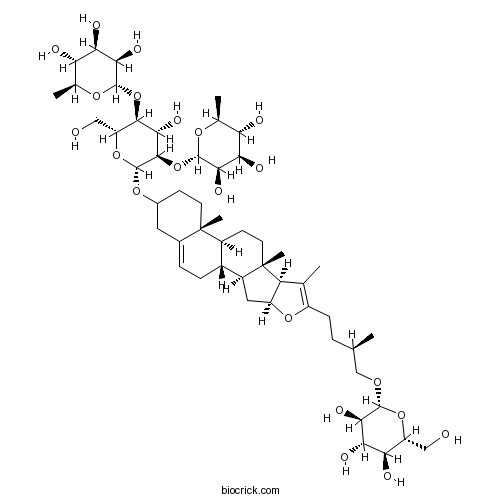
-
BCN2582
Prosapogenin A19057-67-1
Instructions

-
BCN6287
Ruscogenin472-11-7
Instructions
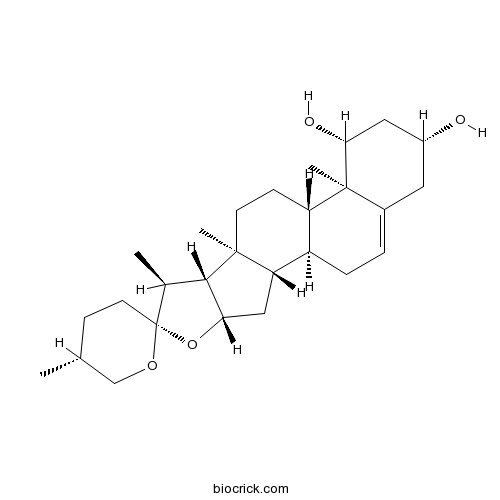
-
BCN5363
Oroxylin A480-11-5
Instructions
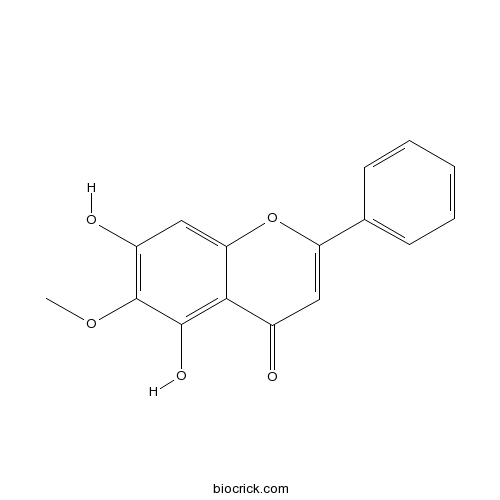
-
BCN5945
Isoliquiritin5041-81-6
Instructions

-
BCN6272
Diosgenin512-04-9
Instructions
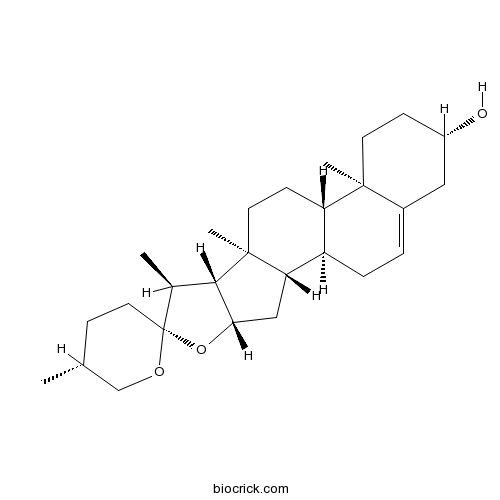
-
BCN1073
Ginsenoside Re52286-59-6
Instructions
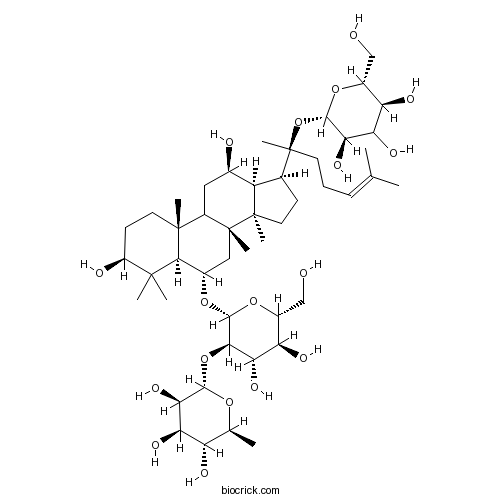
-
BCN4171
Wogonin632-85-9
Instructions

Effect and mechanism of dioscin from Dioscorea spongiosa on uric acid excretion in animal model of hyperuricemia.[Pubmed: 29233733]
Dioscin, a spirostane glycoside, the rhizoma of Dioscorea septemloba (Diocoreacea) is used for diuresis, rheumatism, and joints pain. Given the poor solubility and stability of Dioscin, we proposed a hypothesis that Dioscin's metabolite(s) are the active substance(s) in vivo to contribute to the reducing effects on serum uric acid levels.
The in vivo effects of a fraction from Dioscorea spongiosa on glucocorticoid-induced osteoporosis.[Pubmed: 26979338]
In traditional Chinese medicines, osteoporosis was considered to be induced by the deficiency of kidney's function. The Rhizoma of Dioscorea spongiosa was one of the kidney tonifying and bone strengthening agent in the traditional usage and previous study had shown that its 90% ethanol fraction was effective on anti-osteoporosis using the ovariectomized (OVX) rats. However, for the secondary osteoporosis, like glucocorticoid-induced osteoporosis (GIO), its effect was still unknown.
The in vitro antiosteoporotic activity of some glycosides in Dioscorea spongiosa.[Pubmed: 20118560]
In the investigation of chemical constituents in antiosteoporotic active fraction, 90% ethanol fraction of water extract of the rhizomes of Dioscorea spongiosa, twenty-two glycosides were isolated and their structures were elucidated. In order to know the role of each compound played in the fraction and to find the excellent antiosteoporotic constituent, they were subjected to some in vitro assay experiments with cell lines and an animal organ culture system: stimulation on osteoblasts proliferation and mineralization, inhibition on osteoclasts formation and inhibition on bone resorption. Glycosides 1, 3, 4, 7, 8, 9, 10, 12, 13, 14, 16, 17, 18, 19 and 21 showed significant stimulatory activity on proliferation of osteoblasts. Especially, pregnane glycoside 4, showed the strongest stimulatory activity. The stimulatory activity on osteoblasts mineralization of the compounds stimulating the proliferation significantly was examined and compounds 8, 10, 13 and 16 showed stronger stimulation on osteoblasts mineralization. Their inhibitory activity on bone resorption indicated that only glycosides 5, 13, 14 and 21 possessed significant inhibitory activity at high concentration. Glycosides 9, 11, 14, 18 and 19, isolated in large amount, all showed very strong inhibitory activity on formation of osteoclasts at high concentration, which may be induced by cytotoxicity to bone marrow cells and osteoblasts due to the observation under microscope. It implied that their inhibition on bone resorption may origin from their inhibition on formation of osteoclasts.
The in vitro anti-osteoporotic activity of some diarylheptanoids and lignans from the rhizomes of Dioscorea spongiosa.[Pubmed: 18683123]
Three diarylheptanoids and three lignans from the 90 % ethanol fraction of the rhizomes of DIOSCOREA SPONGIOSA were isolated and subjected to IN VITRO experiments to investigate their activity on osteoblasts and osteoclasts. Diarylheptanoid 1 and furofuran lignan 6 were found to significantly stimulate the proliferation of primary osteoblasts and 6 also mildly stimulated osteoblast mineralization by mouse calvaria osteoblastic cells. All diarylheptanoids and lignans at a concentration of 200 muM completely inhibited the formation of osteoclast-like cells. These results demonstrate that the isolated diarylheptanoids and lignans in the 90 % ethanol fraction have significant anti-osteoporotic activities.
In vivo antiosteoporotic activity of a fraction of Dioscorea spongiosa and its constituent, 22-O-methylprotodioscin.[Pubmed: 15114498]
The antiosteoporotic activity of the 90 % EtOH fraction of the water extract of rhizomes of Dioscorea spongiosa and methylprotodioscin, its major constituent, were examined in the model of postmenopausal bone loss using ovariectomized (OVX) rats or mice. After 6 weeks treatment, the proximal tibia of rats or mice and the distal femora of mice were scanned by peripheral quantitative computed tomography (pQCT). Both the 90 % EtOH fraction (100 mg/kg/d) and methylprotodioscin (50 mg/kg/d) significantly inhibited bone loss in bone mineral content (BMC) and bone mineral density (BMD) in total, cancellous and cortical bones, and the decrease in bone strength indexes induced by OVX, without side effect on the uterus.
New diarylheptanoids from the rhizomes of Dioscorea spongiosa and their antiosteoporotic activity.[Pubmed: 14765294]
Bioassay-guided fractionation of the water extract of the rhizomes of Dioscorea spongiosa led to the isolation and identification of new diarylheptanoids, diospongins A - C, together with three known lignans. Their structures, including absolute stereochemistry, were determined by analyses of NMR data, chemical conversions and CD spectrum. The isolated compounds, except for diospongin A, exerted potent inhibitory activities on bone resorption induced by parathyroid hormone in a bone organ culture system.
Steroidal glycosides from the rhizomes of Dioscorea spongiosa.[Pubmed: 12762799]
A water extract of the rhizomes of Dioscorea spongiosa, which showed antiosteoporotic activity, was examined, and four new pregnane glycosides, named spongipregnolosides A-D (1-4), and two new cholestane glycosides, named spongiosides A (5) and B (6), were isolated together with 15 known glycosides. Their structures were determined on the basis of spectroscopic analysis and chemical methods. Among the isolated compounds, spongioside A (5), hypoglaucin G (7), methylprotodioscin (8), and (R)-oct-1-en-3-yl O-alpha-l-arabinopyranosyl-(1-->6)-alpha-d-glucopyranoside (9) showed potent inhibition against bone resorption induced by parathyroid hormone in a bone organ culture system.
[A second discussion on the position of a new species mianbixie].[Pubmed: 7945849]
The characteristics of Dioscorea spongiosa, or in Chinese Mianbixie, are clearly different from those of D. septemloba in morphology, histology, pollen etc. The establishment of the position of the new species of D. spongiosa is well grounded.


